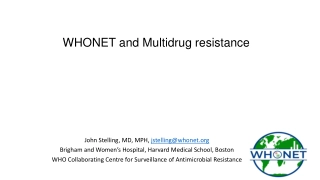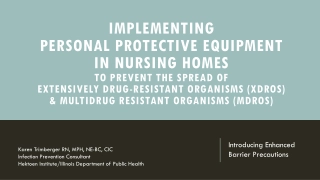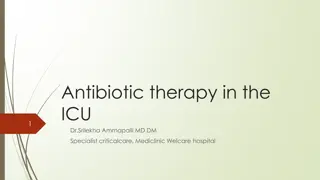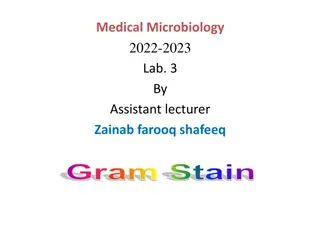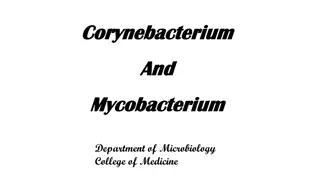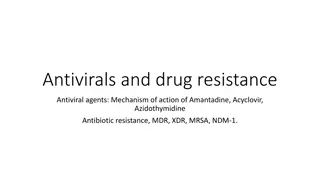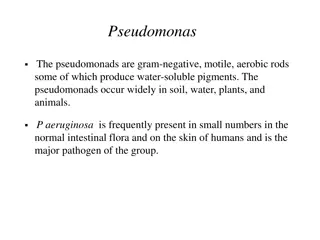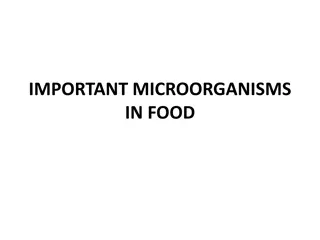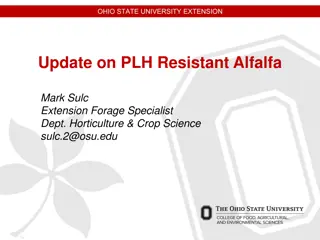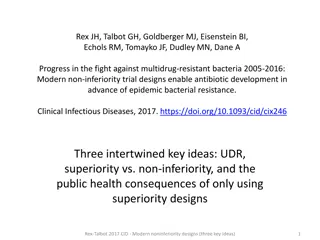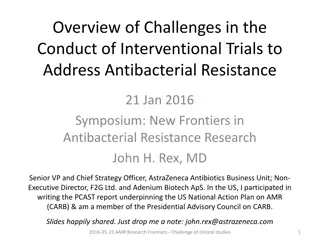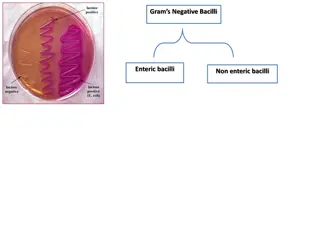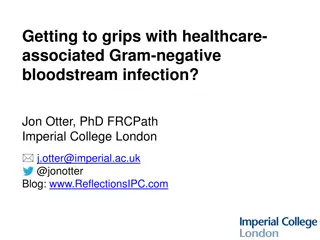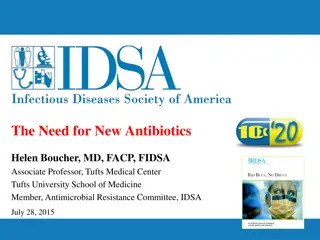Rising to the Challenge of Multidrug-Resistant Gram-Negative Bacteria
The presentation discusses the alarming rise of multidrug-resistant Gram-negative bacteria, highlighting the threat they pose to public health and the economy. Notable figures like Dr. Tom Frieden and Dame Sally Davies emphasize the urgency of taking action to prevent a potential return to a pre-antibiotic era. The significant mortality rates associated with these bacteria, rapid spread through clonal expansion and horizontal gene transfer, and the complexity of acronyms in the field are also covered.
Download Presentation

Please find below an Image/Link to download the presentation.
The content on the website is provided AS IS for your information and personal use only. It may not be sold, licensed, or shared on other websites without obtaining consent from the author. Download presentation by click this link. If you encounter any issues during the download, it is possible that the publisher has removed the file from their server.
E N D
Presentation Transcript
Rising to the challenge of multidrug-resistant Gram- negative bacteria Jon Otter, PhD FRCPath Imperial College Hospitals NHS Trust Hosted by Paul Webber paul@webbertraining.com December 10, 2015 www.webbertraining.com
THE END OF ANTIBIOTICS IS NIGH
Whats the problem? CPE are nightmare bacteria. Dr Tom Frieden, CDC Director If we don't take action, then we may all be back in an almost 19th Century environment where infections kill us as a result of routine operations. Dame Sally Davies, Chief Medical Officer If we fail to act, we are looking at an almost unthinkable scenario where antibiotics no longer work and we are cast back into the dark ages of medicine where treatable infections and injuries will kill once again. David Cameron, Prime Minister, UK The rise of antibiotic-resistant bacteria, however, represents a serious threat to public health and the economy. Barack Obama, President USA 3
Rising threat from MDR-GNB % of all HAI caused by GNRs. % of ICU HAI caused by GNRs. Acinetobacter baumannii Pseudomonas aeruginosa Stenotrophomonas maltophilia Klebsiella pneumoniae Escherichia coli Enterobacter cloacae Non-fermenters CPO Enterobacteriaceae CPE Hidron et al. Infect Control Hosp Epidemiol 2008;29:966-1011. Peleg & Hooper. N Engl J Med 2010;362:1804-1813. 4
Whats the problem? Resistance 6 Courtesy of Pat Cattini
Whats the problem? Mortality Enterobacteriaceae Non fermenters Organism AmpC / ESBL CPE A. baumannii Attributable mortality Moderate Massive (>50%) Minimal Shorr et al. Crit Care Med 2009;37:1463-1469. Patel et al. Iinfect Control Hosp Epidemiol 2008;29:1099-1106. 7
Whats the problem? Rapid spread Clonal expansion Rapid spread Horizontal gene transfer GI carriage 8
Acronym minefield CPC MDR-GNB CPE CRO MDR-GNB ESBL CRC CPE CPE CRAB KPC 10
What are CPE? Carbapenem-resistant Enterobacteriaceae (CPE) Enterobacteriaceae that are resistant to carbapenems by any mechanism. Carbapenemase-producing Enterobacteriaceae (CPE) Enterobacteriaceae that are resistant to carbapenems by means of an acquired carbapenemase. CPE CPE 11
When CPE is not CPE Carbapenemase Wild-type ESBL / AmpC + porin loss or true carbapenemase ? N 0.5 16 Carbapenem MIC Courtesy of Dr Katie Hopkins, PHE. 12
Understanding the enemy C. difficile +/- n/a Pathogen Resistance Resistance genes Species HA vs CA At-risk pts Virulence Environment CPE1 +++ Multiple CPAB2 +++ Multiple MRSA + Single VRE + Single Multiple HA & CA All +++ +/- Single HA (ICU) ICU +/- +++ Single HA Unwell ++ + Single HA Unwell +/- ++ Single HA Old + +++ 1. Carbapenemase-producing Enterobacteriaceae. 2. Carbapenemase-producing Acinetobacter baumannii. 13
CPE in the USA 12 10 8 K. pneumoniae / oxytoca % CPE All Enterobacteriaceae 6 4 2 0 2001 2011 NHSN / NNIS data; MMWR 2013;62:165-170. 14
CPE in the USA 25 community hospitals in Southwestern USA 1.5 CPE rate per 100,000 patient 1 days 0.5 0 2008 2012 15 Thaden et al. Infect Control Hosp Epidemiol 2014;35:978-983.
CPE in LTACs, USA 60 50 % CPE carriers 40 30 20 10 0 ICU LTAC 16 Lin et al. Clin Infect Dis 2013;57:1246-1252.
Whos carrying CPE? Author Adler1 Mack Rai2 Zhao3 Year 2015 2014 2014 2014 Location Israel London East Delhi, India Outpatients Fujian, China Setting CPE carriage in post-acute hospitals, 2008 CPE carriage in post-acute hospitals, 2013 High-risk inpatients and admissions. n patients n carriers % carriers 1147 184 1287 127 2077 7 242 24 303 20 16.0 9.9 0.3 9.9 6.6 Stool samples from hospitalized patients Patients repatriated or recently hospitalized in a foreign country ICU admissions Hospitalized patients Long term acute care hospitals Short stay hospital ICU Birgand4 2014 Paris, France 132 9 6.8 Kim5 Girlich6 Lin7 2014 2014 2013 Seoul, Korea Morocco Chicago, USA Buenos Aires, Argentina 347 77 391 910 1 10 119 30 0.3 13.0 30.4 3.3 Villar8 2013 Non-hospitalized individuals 164 8 4.9 Kothari9 2013 New Delhi, India. Healthy neonates 75 1 1.3 Day10 2013 Pakistan Patients attending a military hospital All admissions to 7 units, including ICU, of 2 hospitals 175 32 18.3 Swaminathan11 2013 New York 5676 306 5.4 N esch- Inderbinen12 Armand- Lef vre13 Zurich, Switzerland 2013 Healthy community residents and outpatients 605 0 0.0 2013 Paris, France ICU patients 50 6 12.0 Wiener-Well14 2010 Jerusalem, Israel Hospitalized patients 298 16 5.4 17 For refs see: http://reflectionsipc.com/2014/12/22/whos-harbouring-cre/
Invasive multidrug-resistant K. pneumoniae 70.0% 60.0% 50.0% % resistant 40.0% Greece Italy Portugal UK 30.0% 20.0% 10.0% 0.0% 2005 2006 2007 2008 2009 2010 2011 2012 2013 18 EARS-Net
Colistin resistance in Italy Survey of 191 CPE from 21 labs across Italy. 43% Colistin resistant K. pneumoniae. Range = 10-80% for the 21 labs. 19 Monaco et al. 2014; Euro Surveill 2014;19:pii=20939.
Emergence of CPE in the UK 20 PHE.
Hand hygiene Antibiotic stewardship HCW screening Cleaning / disinfection Active screening Decol. MDR- GNB Toolbox Contact precautions Cohorting staff / patients Note flagging Env. screening Education 24 Otter et al. Clin Microbiol Infect 2015 in press.
Hand hygiene Antibiotic stewardship HCW screening Cleaning / disinfection Active screening Decol. MDR- GNB Toolbox Contact precautions Cohorting staff / patients Note flagging Env. screening Education 25 Otter et al. Clin Microbiol Infect 2015 in press.
Who do I screen? UK PHE CPE Toolkit screening triggers: a) an inpatient in a hospital abroad, or b) an inpatient in a UK hospital which has problems with spread of CPE (if known), or c) a previously positive case. Also consider screening admissions to high-risk units such as ICU, and patients who live overseas. 26
How do I screen? Rectal swab NAAT (PCR) Agar plate NAAT (PCR) MADLDI- TOF MS AST WGS NAAT = nucleic acid amplification techniques AST = antimicrobial susceptibility testing MALDI-TOF = Matrix-assisted laser desorption /ionization time of flight mass spectrometry WGS = whole genome sequencing 28
Does screening and isolation work? All MDROs MRSA VRE ESBLs Baseline trend Hygiene intervention step-change Hygiene intervention trend change Screening step-change Screening trend change Rapid vs. conventional step-change Rapid vs. conventional trend-change 29 Derde et al. Lancet Infect Dis 2014;14:31-39.
Hand hygiene Antibiotic stewardship HCW screening Cleaning / disinfection Active screening Decol. MDR- GNB Toolbox Contact precautions Cohorting staff / patients Note flagging Env. screening Education 30 Otter et al. Clin Microbiol Infect 2015 in press.
Hand hygiene 40% Median hand hygiene compliance from 95 studies. 31 Erasmus et al. Infect Control Hosp Epidemiol 2010;31:283-294.
Hand hygiene Antibiotic stewardship HCW screening Cleaning / disinfection Active screening Decol. MDR- GNB Toolbox Contact precautions Cohorting staff / patients Note flagging Env. screening Education 32 Otter et al. Clin Microbiol Infect 2015 in press.
Surface survival 7 6 5 C. difficile Log (10) cfu / disc 4 Acinetobacter 3 K. pneumoniae 2 1 0 0 1 2 3 4 5 Time / weeks 33 Otter & French. J Clin Microbiol 2009;47:205-207.
Surface survival strain variation 8 7 6 Log (10) cfu / disc 5 Klebsiella pneumoniae NCTC 9633 4 K. pneumoniae K2 3 K. pneumoniae K41 2 1 0 0 2 4 Time / weeks 34 Otter & French. J Clin Microbiol 2009;47:205-207.
K. pneumoniae vs. E. coli Conclusion K. pneumoniae seems to be more environmental than E. coli.1,2 Surface contamination on five standardized sites surrounding patients with ESBL- producing Klebsiella spp. (n=48) or ESBL-producing E. coli (n=46).1 P<0.001 35 Risk factors for ESBL-E contamination = ESBL- KP, urinary catheter; carbapenem therapy was protective.3 30 25 Klebsiella spp. E. coli % contaminated 20 15 P<0.001 10 5 0 Rooms contaminated Sites contaminated 1. Guet-Revillet et al. Am J Infect Control 2012;40:845-848. 2. Gbaguidi-Haore. Am J Infect Cont 2013;41:664-665. 3. Freeman et al. Antimicrob Resist Infect Control 2014;3:5. 35
Persistent contamination 14 % sites contaminated with A. baumannii % sites contaminated with MRSA 12 % sites contaminated 10 8 140 samples from 9 rooms after 2xbleach 5705 samples from 312 rooms after 4xbleach 2680 sites from 134 rooms after HP vapor 6 4 2 0 Bioquell HP vapor decon 2 x bleach disinfection 4 x bleach disinfection 26.6% of rooms remained contaminated with either MRSA or A. baumannii following 4 rounds of bleach disinfection 36 Manian et al. Infect Control Hosp Epidemiol 2011;32:667-672.
Enterobacteriaceae less environmental 9 8 7 6 Odds ratio 5 4 3 2 1 0 Nseir A.baumannii Nseir P.aeruginosa Nseir ESBL Ajao ESBL Nseir et al. Clin Microbiol Infect 2011;17:1201-1208. Ajao et al. Infect Control Hosp Epidemiol 2013;34:453-458. 37
MDR-GNB cleaning & disinfection checklist Clean / declutter Monitor cleaning process (e.g. fluorescent markers) All equipment disinfected before leaving room Enhanced daily disinfection using bleach Terminal disinfection using bleach or, ideally, H2O2 vapor1-3 1. Gopinath et al. Infect Control Hosp Epidemiol 2013;34:99-100. 2. Snitkin et al. Sci Transl Med 2012;4:148ra116. 3. Verma et al. J Infect Prevent 2013;7:S37. 38
Hand hygiene Antibiotic stewardship HCW screening Cleaning / disinfection Active screening Decol. MDR- GNB Toolbox Contact precautions Cohorting staff / patients Note flagging Env. screening Education 39 Otter et al. Clin Microbiol Infect 2015 in press.
Carbapenem use, Europe 40 ECDC point prevalence survey 2013.
Can we forecast a CPE storm? Could we find and implement an alert level of carbapenem use? The authors claim a stewardship intervention brought the CPE outbreak under control but also implemented case isolation, screening of contacts, barrier nursing and other infection control interventions . Study focussed only on OXA-48 K. pneumoniae; what about other Enterobacteriaceae and non- fermenters. What drives carbapenem resistance? The use of meropenem in the previous year plotted against the incidence rate of OXA-48- producing K. pneumoniae 41 Gharbi et al. Int J Antimicrob Agents 2015 in press.
Antimicrobial stewardship impact Evaluating impact of 6 month antimicrobial stewardship intervention on an ICU by comparing bacterial resistance for matched 6 month periods either side of intervention. 100 90 80 % isolates resistant 70 ** 60 Amikacin Gentamicin Ciprofloxacin Ceftazimime Imipenem 50 * *** 40 30 20 10 0 Before After Before After Before After Enterobacteriaceae Non-fermenters Gram-positive cocci 42 Hou et al. PLoS ONE 2014;9:e101447; * = significant difference before vs. after.
Hand hygiene Antibiotic stewardship HCW screening Cleaning / disinfection Active screening Decol. MDR- GNB Toolbox Contact precautions Cohorting staff / patients Note flagging Env. screening Education 43 Otter et al. Clin Microbiol Infect 2015 in press.
Deisolation? N pts Duration of colonization Author Year Setting Organism Elderly care facilities, Scotland Long term care facility, USA Paediatric hospital, France Long term care facility, USA Patients discharged from hospital, Israel Mean 160 days (range 7-548) Median 77 days (range 47-189) Median 132 days (range 65-228) Median 144 days (range 41 349) Bird1 1998 38 ESBL K. pneumoniae Resistant Gram- negative rods ESBL Enterobacteriaceae Resistant Gram- negative rods Pacio2 2003 8 Zahar3 2010 62 O'Fallon4 2009 33 Zimmerman5 2013 97 CRE Mean 387 days 1. Bird et al. J Hosp Infect 1998;40:243-247. 2. Pacio et al. Infect Control Hosp Epidemiol 2003;24:246-250. 3. Zahar et al.J Hosp Infect 2010;75:76-78. 4. O'Fallon et al.Clin Infect Dis 2009;48:1375-1381. 5. Zimmerman et al.Am J Infect Control 2013;41:190-194. 44
Selective digestive decontamination 20 CRE colonized patients in each arm given gentamicin + polymyxin (SDD arm) or placebo (Control arm) 100 Percentage of CRE positive 80 rectal samples 60 SDD Control 40 20 0 0 9 days 2 weeks 4 weeks 6 weeks 45 Saidel-Odes et al. Infect Control Hosp Epidemiol 2012;33:14-19.
Decolonisation using faecal microbiota transplantation (FMT) 82 year old colonised with CPE. Carriage was delaying her admission to a nursing home. Single dose of FMT decolonised her at 7 and 14 days. Laiger et al. J Hosp Infect 2015 in press. Buffie & Pamer. Nat Rev Microbiol 2013;13:790-801. 47
Chlorhexidine efficacy Impact of chlorhexidine gluconate (CHG) daily bathing on skin colonization with KPC-producing K. pneumoniae in 64 long-term acute care patients. 60 % patients with CRE colonization 50 at one or more sites 40 30 20 10 0 Before CHG After CHG 48 Lin et al. Infect Control Hosp Epidemiol 2014; 35:440-442.
Chlorhexidine reduced susceptibility Proportion of BSI isolates with reduced susceptibility to chlorhexidine on units using chlorhexidine gluconate (CHG) daily bathing (n=28) or not (n=94). 100 % isolates with reduced 80 CHG susceptibility 33% (p=0.028) 60 40 20 0 CHG Non CHG 49 Suwantarat et al. Infect Control Hosp Epidemiol 2014;35:1183-1186.
Hand hygiene Antibiotic stewardship HCW screening Cleaning / disinfection Active screening Decol. MDR- GNB Toolbox Contact precautions Cohorting staff / patients Note flagging Env. screening Education 50 Otter et al. Clin Microbiol Infect 2015 in press.


